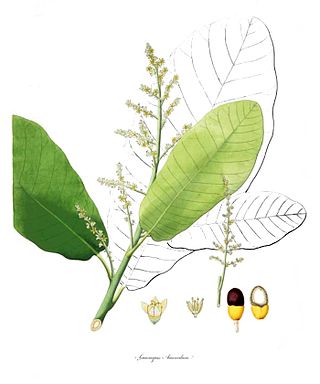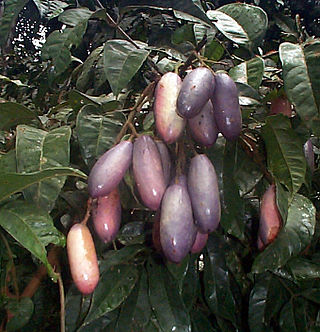
Judith Blume is an American writer of children's, young adult and adult fiction. Blume began writing in 1959 and has published more than 25 novels. Among her best-known works are Are You There God? It's Me, Margaret (1970), Tales of a Fourth Grade Nothing (1972), Deenie (1973), and Blubber (1974). Blume's books have significantly contributed to children's and young adult literature.

Mangifera is a genus of flowering plants in the cashew family, Anacardiaceae. It contains approximately 69 species, with the best-known being the Common Mango. The center of diversity of the genus is in the Malesian ecoregion of Southeast Asia; particularly in Sumatra, Borneo, and the Malay peninsula. They are generally canopy trees in lowland rainforests, reaching a height of 30–40 m (98–131 ft).

Canarium is a genus of about 100 species of tropical and subtropical trees, in the family Burseraceae. They grow naturally across tropical Africa, south and southeast Asia, Indochina, Malesia, Australia and western Pacific Islands; including from southern Nigeria east to Madagascar, Mauritius, Sri Lanka and India; from Burma, Malaysia and Thailand through the Malay Peninsula and Vietnam to south China, Taiwan and the Philippines; through Borneo, Indonesia, Timor and New Guinea, through to the Solomon Islands, Vanuatu, New Caledonia, Fiji, Samoa, Tonga and Palau.

Phoebe is a genus of evergreen trees and shrubs belonging to the Laurel family, Lauraceae. There are 75 accepted species in the genus, distributed in tropical and subtropical Asia and New Guinea. 35 species occur in China, of which 27 are endemic. The first description of the genus was of the type species P. lanceolata made in 1836 by Christian Gottfried Daniel Nees von Esenbeck in Systema Laurinarum, p. 98.
Canarium littorale is a tree found in tropical Asia and is a member of the incense tree family Burseraceae. The specific epithet littorale is from the Latin meaning "of the seashore", referring to its habitat.
Santiria apiculata is a species of flowering plant in the family Burseraceae. It is found in Indonesia, Malaysia, the Philippines, and Singapore.
Santiria laevigata is a species of plant in the Burseraceae family. It is found in Indonesia, Malaysia, the Philippines, and Singapore.
Santiria nigricans is a species of plant in the family Burseraceae. It is a tree endemic to Borneo where it is confined to Sarawak.

Semecarpus is a genus of plants in the family Anacardiaceae.

Dacryodes is a genus of about 60 species of trees in the family Burseraceae. The generic name is from the Greek dakruon meaning "tear(drop)", referring to how resin droplets form on the bark surface.
Canarium dichotomum is a tree in the family Burseraceae. The specific epithet dichotomum is from the Latin meaning "forked", referring to the branching of the inflorescences.
Canarium denticulatum is a tree in the family Burseraceae. The specific epithet denticulatum is from the Latin meaning "small teeth", referring to the leaf margin.

Dacryodes rostrata is a tree in the family Burseraceae. The specific epithet rostrata is from the Latin meaning "beaked", referring to the narrow-tipped leaves.
Dacryodes rugosa is a tree in the family Burseraceae. The specific epithet rugosa is from the Latin meaning "wrinkled", referring to the leaflets.
Dacryodes rugosa var. virgata is a tree in the family Burseraceae.
Buchanania insignis is a tree of Borneo in the cashew and sumac family Anacardiaceae. The specific epithet insignis is from the Latin meaning "remarkable".
Buchanania sessilifolia is a tree in the family Anacardiaceae. The specific epithet sessilifolia is from the Latin meaning "leaf without stalk", referring to the sessile leaves.
Dracontomelon costatum is a tree in the cashew and sumac family Anacardiaceae. The specific epithet costatum is from the Latin meaning "ribbed", referring to the leaf veins.

Gluta velutina is a plant of tropical Asia in the cashew and sumac family Anacardiaceae. The specific epithet velutina is from the Latin meaning "velvety", referring to the inflorescences.








